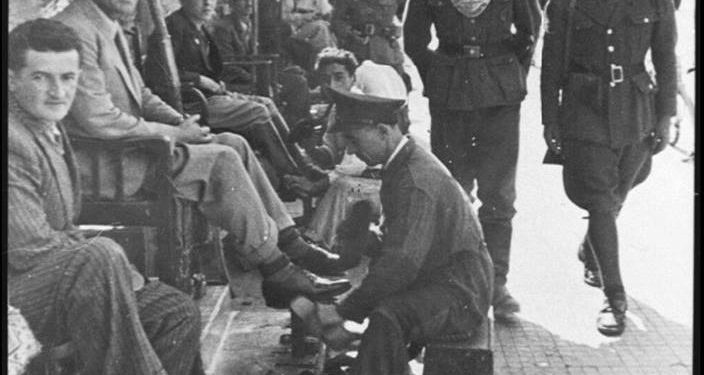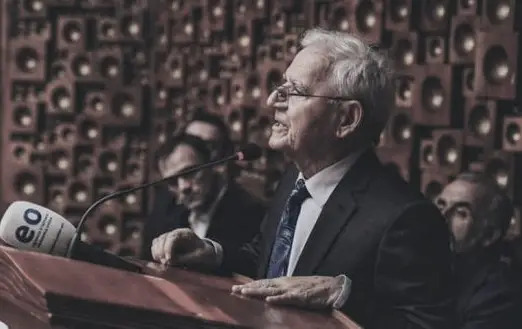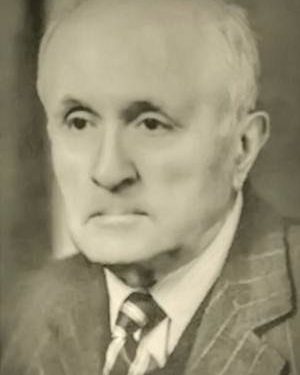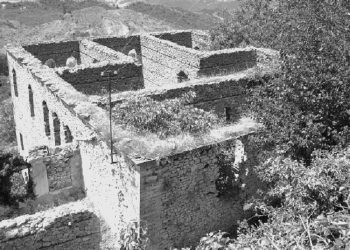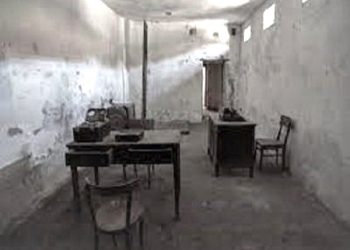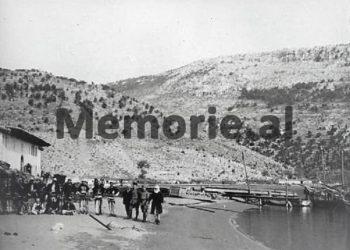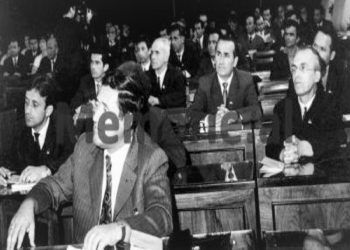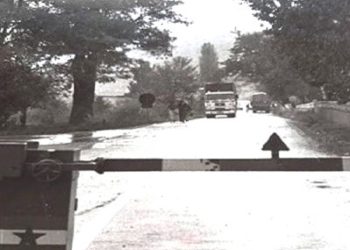By Prof. Dr. Ramiz ABDYLI
Memorie.al / The anti-Bulgarian demonstration of the Albanians in Skopje, organized on May 10, 1941, has left an indelible mark in the history of our people, which today and that day is taken as an example of the courage of high patriotism, aiming at national unity, within the framework that the circumstances of the time allowed. The creators of the Demonstration and the Movement for Liberation and National Reunification aimed to bring to life the ideal of the unification of the Albanian Ethnic Territories, after the withdrawal of the fascist invaders. After the disintegration of the Kingdom of Yugoslavia, in April 1941, the Albanian lands, which were part of it, were divided between Italy, Germany and Bulgaria. According to the agreement between them, Italy received most of today’s Kosovo and the Albanian Eastern Troy from Struga to Grupcin (between Skopje and Tetovo), the southern part of Sanjak of the New Market, as well as the territory of Ulcinj.
These lands were officially called “Free Lands”. Germany occupied the area of Mitrovica and most of Llapi. While Bulgaria occupied the territories inhabited by Albanian majority, from the Morava River to the west, including Kaçanik, and the provinces of Skopje, Kumanovo, Preševo, Bujanovac, Ohrid, Manastir, Prilep and Veles.
The unbearable condition under the Bulgarian occupation
The Italian conqueror in “Tokat e Lirueme” allowed the use of Albanian as an official language, alongside Italian, the development of learning in schools, the organization of the cultural life of Albanians as well as the use of the national flag, although with the sign of the Lictor (Fasho). In the territories occupied by Germany, Albanian students were given the opportunity to study in their native language, but the direction of the local government was held by the Serbs. The situation was completely different in the territories occupied by Bulgaria. Albanians under the Bulgarian fascist regime (1941-1944) constituted the dangerous element, hated to the extent of Nazism, who were denied the right to live in their lands.
At the core of this regime’s Albanophobia was the ability of the Albanians who had survived the conquering regimes over the centuries and were in their lands, where God had left them. Therefore, a series of measures were taken against them to force them to move. Here were the reasons for them to live under the conditions of military and police curfew. Thus, the ethnic cleansing of the Albanian lands and their transformation into Bulgarian lands was intended.
The measures of violence and terror coincided with the organization of police and military expeditions through the Albanian provinces, the arrests of men and the exercise of violence on them, up to the point of death, the violence of girls and women, the contempt of men by removing the pleats in public places and the obligation to wear Bulgarian hats, the doors of houses had to be open, in order to have faster access to the police. Everything that was valuable to them was looted, from valuables, livestock, grain, etc. High and unaffordable taxes helped this situation.
One of the methods of violence was hitting the arrested with unengraved Scotch sticks, according to the 1-25 system, which meant; 25 uncles, counted 1. Most of the times, the abused were forced to count themselves. This meant that the arrested person was given 25 unengraved Scots stamps, but their number was much higher. Often the count of the dayaks ended at the number 24. When this number was reached, the punished person was told that he had made a mistake. Then it started all over again. Those who were healthy, could not withstand the pressure and died. There were also cases when the punished ended up in the oven. The Bulgarian police did not leave untouched even the most sensitive issue, in the Albanian moral norms: the rape of women.
A severe measure of punishment was the mobilization of young Albanian boys in the so-called “Trudovi druzhini” (work groups). Those mobilized were sent to forced labor in Bulgaria, usually for the construction of military and civil facilities (roads, opening tunnels, etc.), where they lived in conditions of concentration camps. In the factory, the norm was almost no arrivals, long working hours, while the food was almost calorie-free. Those who failed to meet the norm were subjected to the 1-25 dayak system. Even those who exceeded the norm were beaten because they had not adhered to the work rules. Consequently, many of these young people left their remains in the mentioned facilities in Bulgaria.
In short, the attitude of the Bulgarian invaders towards the Albanians was unprecedented, extremely discriminatory and liquidating. People were arrested without reason and the terror on him increased day by day. These were the reasons that a part of the Albanians was forced to emigrate to the lands occupied by Italy, or to go to the mountains, to organize a guerilla war. The violence and repression of this invader encouraged the leaders of the National Movement of these lands to organize to oppose him.
From the middle of April 1941, they established in Tetovo; “Albanian Committee”, headed by Shaip Kamberi. With its program, the Committee aimed at the extension of Italian power in the Albanian territories occupied by Bulgaria. On April 18, at the initiative of Shaban Efendi, a meeting was organized in Kumanovo, in which the leaders of Presheva also participated. It was attended by: Preshevo’s lawyer, Abdullah Saqipi, Preshevo’s Mufti, Lutfi Ahmeti, Abdullah Osmani from Kumanova and Abdullah Veliu from Presheva.
It was agreed to hold a meeting with representatives of the entire occupied Bulgarian area in Skopje. In the second part of April, a meeting of representatives of Troy occupied by Bulgaria was organized in Bojali-Han, Skopje. In that meeting took part: Shaban Efendi Osmani, Aqif Tetova from Gjilan, Shaip Mustafa from Presheva, Jahja Osmani from Kumanova, Abdullha Veliu from Presheva, Hafëz Lutfiu from Presheva, Abdullha Saqipi from Presheva and Idriz Ymeri from Tetova. It was agreed to establish the “Movement for National Liberation and Unity” and a delegation was set up, headed by Shaban Efendi Osmani, to consult with the governors of Albania about the measures that had to be taken against the Bulgarian violence.
It was decided to organize a demonstration against Bulgarian violence in Skopje. The LÇBK delegation headed by Shaban Efendi traveled to Dibër and Tirana, with the request that the areas inhabited by an Albanian majority should join Ethnic Albania, because those lands “belong to the Albanian nation”. But the Albanian governors hesitated to respond to a very sharp political issue. These were the suggestions of the Albanian consul in Skopje, Hamit Kokalari. After returning to Skopje, a gathering of intellectuals from the occupied territories was organized in Bojali-Han. It was agreed on the organization of the demonstration on May 10, 1941, with the request that: Skopje, Kumanova, Presheva and the eastern parts of Gjilan, which have an Albanian majority, should join Albania”.
Demonstration preparation
The demonstration, to be held on May 10, 1941 in Skopje, was organized after 20 days of the Bulgarian occupation. In order to ensure its national success, the provinces of Skopje, Kumanovo, Presevo, Bujanovac, as well as other Albanian territories, took action on the ground to raise the awareness of the population, that it was necessary to organize a demonstration in Skopje. In the numerous meetings organized in villages and cities, propaganda material was distributed, as well as free blankets.
This is stated in a document of Bulgarian police origin, of that time. According to him; “Albanian propagandists, supplied with leaflets, have visited the biggest cities in Macedonia, to develop propaganda…”! It was further said that; the organizers of the demonstration had a quantity of pleats intended for those who would participate in the demonstration. Flyers were also distributed on the ground, in which they talked about the importance of organizing the demonstration and asked for the extension of Italian power in the territories occupied by Bulgaria.
They organized meetings in cities and villages, where with the men of the neighborhood of the city or the village, they developed propaganda against the Bulgarian invaders, condemning the violence and repressive measures exercised by this invader and demanding the union with the “Free Lands”, putting apparently the advantages that were there, in the sphere of national rights. The leaders of the LKÇB were convinced that in this way the preconditions for the realization of the ideal of national unity would be ensured, even after the departure of the Italian and German fascist invaders from the Albanian Ethnic Troy.
Development of the Demonstration
For the demonstration in Skopje, they made proper preparations, evoking the high national morale to face the police and army forces, which would oppose the demonstrators mercilessly, without choosing the means, a practice that had already been tried and tested. times. Against them, the patriotism of the Albanian boyhood would be put. In the morning of May 10, hundreds of patriots of Skopje, Kumanovo and Preševo gathered in front of the Bojali-Han building, the symbol of the unification of the occupied lands. At the head of them were the leaders of LBÇK. According to an article, where the Skopje demonstration is clearly mentioned, it was said that; Shaip Mustafa Presheva and Jahja Osman Kumanova were at the head of the demonstration. This is what R. Bunjaku, one of the participants, says.
Qemal Sejfullau, in one of his articles, says that; organizers of the demonstration were; “certain nationalists”, but does not say who they were. According to the report of Spiro Kitinčev, leader of the demonstration, it was Idriz Hoxha, proposed by a group of the Skopje parish. It seems that alongside them as well as Shaban Efendi, co-organizers of the demonstration, there were also three groups from Skopje.
The first group was led by Hasan Shukriu, Qemal bey and Emin bey-Kumbaraxhiu; The second group was led by Shefki Ramiz bey, while the third group was led by Atullah Hoxha. Meanwhile, the employee of the Bulgarian secret service in Skopje, Stoilov, says that; “Said Idriz Hoxha (Sait Hoxha), deputy in the Ottoman Parliament and one of the leaders of the uprising of 1912 (T.L) was “the main organizer of the Albanian demonstrations in Skopje, in 1941, when the union of Skopje with Albania was requested”. He says that this initiative was made by “Italian Albania”.
While Sai Hoxha’s close collaborators, according to him, were: Qemal Rustem bey, Rustem Rustemi and Atulla Hoxha, and that their request was the union of Skopje with Albania. According to him, they were the most active in Skopje and for the realization of their objective they also sought the support of the Turks of the city of Skopje. It is not known if these were the main leaders or co-organizers. It should have been the second one, because there is evidence that one of them was Shaip Mustafa, together with Jahja Osman.
It should be taken into account that; in the circumstances at that time, even the Albanian communist wing, with Shaip Mustafa and Jahja Osmani, had a national tendency. They belonged to the national wing of the Albanian communists, which was small, in front of the communist wing, with an international orientation and no national base.
Shaip Mustafa, according to a document, requested permission for the organization of the demonstration from Metodija Sharlo Shatarov, secretary of the Provincial Committee of the Communist Party of Yugoslavia for Macedonia, in order to “avoid the violence of the Bulgarian occupier that was exerted on the Albanians and the territories occupied by them”. Shaip Mustafa, was one of the first communists in Southern Serbia and one of the organizers of the demonstration against the Bulgarian occupation. It should be noted that, in March 1943, Shuaip Mustafa came into conflict with Svetozar Vukmanovic Tempo, in Gjilan.
When he reprimanded him for not committing to the mobilization of the Albanians of the eastern lands, in the War against the fascist invaders, he asked for a written guarantee that the Albanians’ right to national unity would be recognized. If this right were guaranteed, he would be able to mobilize a brigade of young Albanians in a short time. This, as well as the organization of the demonstration in Skopje, were the reasons that Shaip Mustafa, after the end of the War, would be sentenced to 18 years of imprisonment.
However, the unification of national forces, without ideological differences, and in support of a national ideal, was one of the distinguishing advantages of this demonstration. It was the national ideal that united the leaders of Eastern Troy and was an example to be envied, which constituted a powerful impetus for the organization of the demonstration, the mobilization of Albanians to participate in that important event in our history.
In the morning of May 10, 1941, in front of Bojali-Han in Skopje, hundreds of Albanians gathered, with national flags and with pleats on their heads. In front of them were several leaders of LBÇK as well as Shaip Mustafa and Jahja Osmani. Demonstrators started chanting the programmatic request of the LÇBK: “Shkopi, Kumanova and Presheva are Albanian”, “Shkopi is ours”, etc. In the parade to Çarshi, they were joined by the students and teachers of the “Gazi Isa Bey” Madrasah, who were led by Bedri Haliti, as well as some Bosnians and “Turks”, with Atullah Hoxha and Shefki Ramiz, at the head.
It is to notice the phenomenon that; The “Turks” publicly threw away the fez and replaced them with pleats, as well as supported the request for joining “Tokat e Lirueme”. This constituted an additional concern for the Bulgarian police, because the support of the Albanian request, according to a document; “talk to much”. Even in another Bulgarian document, it is noted that what worried the Bulgarian military and police authorities the most were the numbers of Bosniaks and Turks in the demonstration.
Demonstrators, after passing the Old Bazaar of Skopje, turned to the Bulgarian Military Command, the General Staff of the German Army, to continue to the Italian Consulate, which was located on the right side of the Stone Bridge, in the Officers’ House, hence the former – Burmali Mosque, with their chorus.
Some demonstrators even broke the windows of this embassy, as a sign of anger because it was not meeting their demands. In the moments when the demonstrators were crossing the Stone Bridge, the Bulgarian army and police were put into action, to prevent and disperse the demonstrators, and with them the programmatic demand of the LCBK. According to Ramiz Bunjak, the demonstrators rushed against the police and showed great courage in fighting with him. According to him, Shaip Mustafa stood out in this fight. Despite the rare courage shown, the hands against the special forces, with a large number of policemen and soldiers, faced their attacks for a while.
Their attitude against the rubber batons gave results, but not against the butts of the rifles, which caused severe wounds, broken legs, hands, ribs and other parts of the body. And finally, the Bulgarian special police also fired a gun. This eventually dispersed the demonstrators. The Bulgarian military and police authorities, with the force of the strongest, succeeded in dispersing the demonstrators and arrested a significant number of participants, who sent them to the Police Command of the city of Skopje, as well as to the Headquarters of the Bulgarian army in Skopje.
There they were beaten and ill-treated for several days, then some were sentenced to a fixed term of imprisonment. Meanwhile, special units exercised severe violence in many towns and villages inhabited by Albanians, with the slogan; “This is Bulgaria”, in response to the demonstrators’ slogan; “Skopje and Kumanova are Albania”. After the April 10 demonstration, the Bulgarian police arrested hundreds of demonstrators, among them the leaders of the LCBK, such as: Shaip Mustafa, Yahja Kumanova, Yahja Saitin, Azem Latif Hoxha from Kumanova, Ejup Saitin from Skopje, Shemsi Hatipin, etc., who were mistreated in the Mosque of Yahya Pasha, or interned in concentration camps in Bulgaria, as was the case with Shaip Mustafa and Yahya Osman.
Raha was killed by hundreds of Albanians from the province of Skopje, Kumanovo and Presheva. Through many Albanian villages, they looted everything of value, especially gold ornaments. The Bulgarian gendarmerie arrested the two pleat merchant brothers, Mahmut and Hakiu, in the Skopje Bazaar, because they had supplied the demonstrators with pleats. Mahmut could not cope with the uncle and died. The Bulgarian gendarmerie arrested more than 300 Albanians, tore off their pleats and sent them to the military barracks in this neighborhood. The Bulgarian terror continued to be exercised on the Albanians of the occupying area during the entire period of the occupation.
In the end, it can be considered that; the anti-Bulgarian demonstration of the Albanians in Skopje, organized on May 10, 1941, has left an indelible mark in the history of our people, which today is taken as an example of the courage of high patriotism, aiming at national unity, within the framework that the circumstances of the time allowed. The creators of the Demonstration and the Movement for National Liberation and Reunification aimed to unite with Italy, not because it was fascist, but to avoid Bulgarian violence, and to bring to life the ideal of the union of the Albanian Ethnic Territories, after the withdrawal of the fascist invaders. Memorie.al




